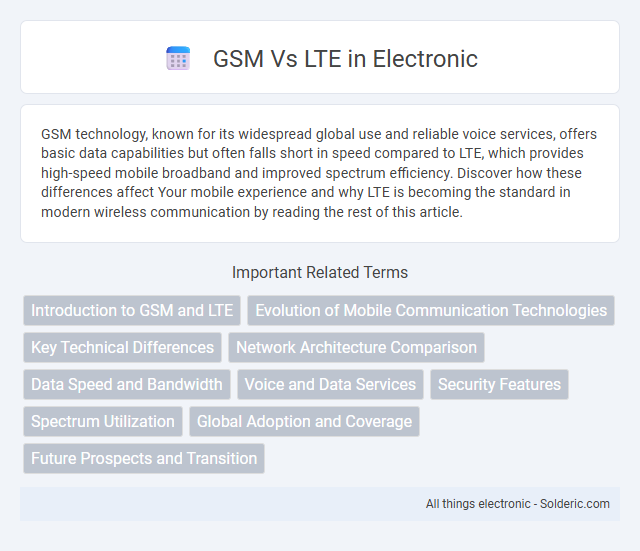GSM technology, known for its widespread global use and reliable voice services, offers basic data capabilities but often falls short in speed compared to LTE, which provides high-speed mobile broadband and improved spectrum efficiency. Discover how these differences affect Your mobile experience and why LTE is becoming the standard in modern wireless communication by reading the rest of this article.
Comparison Table
| Feature | GSM (Global System for Mobile) | LTE (Long Term Evolution) |
|---|---|---|
| Technology Type | 2G Cellular Network | 4G Cellular Network |
| Data Speed | Up to 114 Kbps | Up to 1 Gbps (Download) |
| Frequency Bands | 850 MHz, 900 MHz, 1800 MHz, 1900 MHz | 700 MHz to 2600 MHz (varies by region) |
| Technology Type | Circuit-Switched | Packet-Switched |
| Latency | 300-400 ms | 10-50 ms |
| Voice Support | Native Circuit-Switched Voice | VoLTE (Voice over LTE) required |
| Modulation | GMSK (Gaussian Minimum Shift Keying) | OFDM (Orthogonal Frequency-Division Multiplexing) |
| Network Architecture | 2G Core Network (MSC, BSS) | Evolved Packet Core (EPC) |
| Use Case | Basic voice calls, SMS, low speed data | High-speed internet, video streaming, VoIP |
Introduction to GSM and LTE
GSM (Global System for Mobile Communications) is a 2G technology that revolutionized mobile communication by enabling digital voice calls and basic data services globally. LTE (Long Term Evolution) represents a significant advancement as a 4G technology, providing high-speed internet access, improved latency, and enhanced capacity for mobile broadband. Your mobile experience shifts from primarily voice-centered with GSM to data-centric connectivity with LTE, supporting modern applications and seamless streaming.
Evolution of Mobile Communication Technologies
GSM (Global System for Mobile Communications) laid the foundation for digital voice services and basic data transmission with speeds up to 14.4 kbps, revolutionizing mobile communication in the early 1990s. LTE (Long-Term Evolution) represents a significant advancement, delivering high-speed data transfer rates exceeding 100 Mbps, enabling seamless streaming, video calls, and internet browsing on your mobile device. This evolution from GSM to LTE reflects a shift from voice-centric to data-centric networks, meeting the increasing demand for faster and more reliable mobile connectivity.
Key Technical Differences
GSM operates on 2G technology using TDMA and FDMA for voice and low-speed data, while LTE employs 4G technology with OFDMA and MIMO for high-speed data and improved spectral efficiency. LTE utilizes IP-based packet switching, enhancing data throughput and reducing latency compared to GSM's circuit-switched network. Understanding these key technical differences can help you choose the right network technology for faster data communication and better overall performance.
Network Architecture Comparison
GSM operates on a circuit-switched network architecture designed primarily for voice communication, relying on components like the Base Station Subsystem (BSS), Mobile Switching Center (MSC), and Home Location Register (HLR). LTE utilizes a flat IP-based packet-switched architecture featuring the Evolved Packet Core (EPC) and eNodeB, which supports higher data rates and seamless mobility. The LTE architecture enables scalable and efficient data transport with reduced latency compared to the hierarchical and voice-centric GSM network design.
Data Speed and Bandwidth
GSM technology offers data speeds up to 14.4 kbps, supporting basic mobile communication primarily for voice and limited data services. LTE significantly increases your data speed potential, providing peak download rates exceeding 100 Mbps and greater network bandwidth to handle high-definition streaming and large file transfers. This enhancement in LTE's bandwidth allows for more simultaneous connections and improved overall network efficiency compared to the older GSM standard.
Voice and Data Services
GSM networks primarily support voice calls with limited data capabilities through GPRS and EDGE technologies, offering slower data speeds compared to modern standards. LTE is designed for high-speed data transmission, providing seamless voice services via VoLTE (Voice over LTE) for better call quality and reduced latency. The transition from GSM to LTE marks a significant upgrade in mobile networks, enhancing both voice clarity and data efficiency.
Security Features
GSM employs A5/1 and A5/2 encryption algorithms for voice and data security, but these older protocols are vulnerable to interception and eavesdropping. LTE enhances security with advanced protocols such as EPS-AKA for mutual authentication and uses robust encryption standards like AES to protect data integrity and confidentiality. The LTE network also supports integrity protection of signaling messages, significantly reducing the risk of man-in-the-middle attacks compared to GSM.
Spectrum Utilization
GSM primarily operates in the 900 MHz and 1800 MHz frequency bands, offering narrowband spectrum allocation optimized for voice and basic data services. LTE utilizes a broader range of spectrum, including bands from 700 MHz to 2.6 GHz, enabling wideband channels that support higher data throughput and improved spectral efficiency. Advanced technologies like carrier aggregation and MIMO in LTE significantly enhance spectrum utilization compared to GSM.
Global Adoption and Coverage
GSM remains the most widely adopted 2G technology with coverage spanning over 200 countries, making it ideal for voice calls and basic data services. LTE, representing the evolution to 4G technology, offers significantly faster data speeds and improved network capacity, now covering approximately 160 countries with expanding reach. Your mobile experience benefits from LTE's global expansion, especially for high-speed internet and multimedia applications, while GSM ensures broad compatibility in remote or less developed regions.
Future Prospects and Transition
GSM networks, while historically vital for mobile communication, are gradually being phased out as LTE technology offers superior data speeds, lower latency, and enhanced network capacity. The transition from GSM to LTE is accelerating globally, driven by increasing demand for high-speed mobile internet and the expansion of IoT devices requiring reliable connectivity. Your future mobile experience will increasingly depend on LTE infrastructure, enabling advanced services and seamless communication.
GSM vs LTE Infographic

 solderic.com
solderic.com